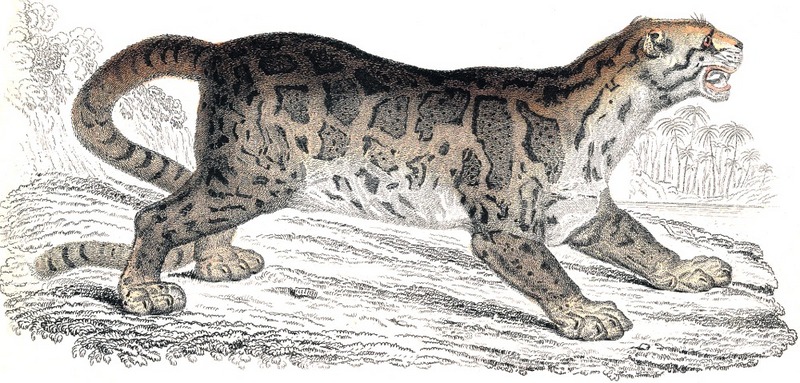|
Bornean Clouded Leopard (Neofelis diardi) - Wiki
| 제목: | Bornean Clouded Leopard (Neofelis diardi) - Wiki
| |

| 해상도: 1000x479
파일크기: 255357 Bytes
등록시간: 2007:11:02 13:39:45
|
Bornean Clouded Leopard
From Wikipedia, the free encyclopedia
[Photo] Bornean Clouded Leopard (Neofelis diardi). Plate from William Jardine's The Natural History of The Feline, Rimau-Dahan, published 1834.
The Bornean Clouded Leopard or Diard's Leopard (Neofelis diardi) is a medium-sized wild cat found on Borneo, Sumatra and the Batu Islands in the Malay Archipelago and publicised under the name Bornean Clouded Leopard by the World Wide Fund for Nature (WWF) on March 14, 2007. Its coat is marked with irregularly-shaped, dark-edged ovals which are said to be shaped like clouds, hence its common name. Though scientists have known of its existence since the early 19th century, it was positively identified as being a distinct species in its own right in 2006, having long been believed to be a subspecies of the mainland Clouded Leopard (Neofelis nebulosa). WWF quoted Dr. Stephen O'Brien of the U.S. National Cancer Institute as saying, "Genetic research results clearly indicate that the clouded leopard of Borneo should be considered a separate species".
Anatomy and morphology
The Bornean Clouded Leopard has a stocky build, weighing about 25 kg (55 pounds). It is the largest predator in Borneo. The majority of its prey lives in trees, necessitating its excellent climbing skills. With short, flexible legs, large paws, and keen claws, this big cat is very sure-footed. The canine teeth are two inches long, longer than those of any other extant feline. Its tail can grow to be as long as its body, aiding balance.
Distribution
The Bornean Clouded Leopard's range is Borneo and Sumatra in the Malay Archipelago. The species was previously found in Java, but has not been recorded there since Neolithic times.
Ecology and life history
Habitat
N. diardi's preferred habitat is tropical and subtropical forest at altitudes up to about 2,000 metres (6,500 ft).
Behaviour
The habits of the Bornean Clouded Leopard are largely unknown because of the animal's secretive nature. It is assumed that it is generally a solitary creature.
Etymology and taxonomic history
Despite its name, the Bornean Clouded Leopard is not closely related to the leopard. The species was named Neofelis diardi in honor of French naturalist and explorer Pierre-M??dard Diard; in the 19th century Felis diardii designated the Clouded Leopard/Bornean Clouded Leopard, colloquially "Diard's Cat". The local names, "Macan Dahan" in Indonesian and "Harimau Dahan" in Malay (also reported historically in Sumatra), mean "tree branch tiger".
The species was long regarded as a subspecies of the Clouded Leopard, named Neofelis nebulosa diardi. In December 2006, two articles in the journal Current Biology detailed a strong case for reclassifying and redefining two distinct species of Clouded Leopard: Neofelis nebulosa from mainland Asia and Neofelis diardi from the Malay archipelago. A UK study led by Andrew C. Kitchener detailed geographical variations in the Clouded Leopard, indicating a split of two species. The results of a morphometric analysis of the pelages of fifty-seven Clouded Leopards sampled throughout the genus' wide geographical range concluded that there were two distinct morphological groups, differing primarily in the size of their cloud markings. Another study led by Valerie A. Buckley-Beason cited molecular evidence for the species-level distinction of the Clouded Leopard, although the study only used DNA samples from the Bornean population and mainland Asia and not from the Sumatran population. The genetics study found differences in the molecular genetic analyses (mtDNA, nuclear DNA sequences, microsatellite variation, and cytogenetic differences) of the different species of Clouded Leopard. Among the molecular disparities between the two species were thirty-six fixed mitochondrial and nuclear nucleotide differences and 20 microsatellite loci with nonoverlapping allele-size ranges. The study stated that the degree of differentiation was similar to the differences between the five Panthera species, thus concluding that Neofelis diardi is a separate species from Neofelis nebulosa.
Evolutionary history
The genetic analysis of Neofelis nebulosa and Neofelis diardi suggest the two species diverged 1.4 million years ago, after the animals used a now submerged land bridge to reach Borneo and Sumatra from mainland Asia.
Conservation
Because the Bornean Clouded Leopard's habits make it difficult to study, exact figures of its population do not exist. However, recent studies estimate the population to be between 5,000 and 11,000 great cats left on Borneo, and 3,000 to 7,000 on Sumatra. In the countries of its native range, hunting of the Clouded Leopard is prohibited. However, these bans are very poorly enforced.
Some of data comes from a 2006 study which classified tracks in one part of Sabah (northeastern Borneo). This study estimated that there are 1,500???3,200 cats in Sabah, with only 275???585 of them in large protected reserves.
Encroachment on natural habitat, primarily by logging and the planting of rubber and palm oil plantations, continues to threaten the whole fauna of Borneo, including the Bornean Clouded Leopard.
http://en.wikipedia.org/wiki/Bornean_Clouded_Leopard
| The text in this page is based on the copyrighted Wikipedia article shown in above URL. It is used under the GNU Free Documentation License. You may redistribute it, verbatim or modified, providing that you comply with the terms of the GFDL. |
|
^o^
동물그림창고 똑똑전화 누리집
^o^
|
|